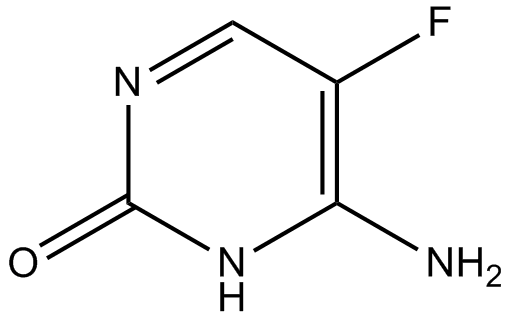Flucytosine (Synonyms: Ancobon, Ancotil, 5FC, NSC 103805, Ro 29915) |
| Catalog No.GC13753 |
Antifungal drug
Products are for research use only. Not for human use. We do not sell to patients.

Cas No.: 2022-85-7
Sample solution is provided at 25 µL, 10mM.
Flucytosine (5-Fluorocytosine, 5-FC, Ancobon), a fluorinated pyrimidine analogue, is an antifungal drug.Target: antifungalFlucytosine, or 5-fluorocytosine, a fluorinated pyrimidine analogue, is a synthetic antimycotic drug. It is structurally related to the cytostatic fluorouracil and to floxuridine. It is available in oral and in some countries also in injectable form. A common brand name is Ancobon. Flucytosine was first synthesized in 1957 but its antifungal properties were discovered in 1964. The drug is dispensed in capsules of 250 mg and 500 mg strength. The injectable form is diluted in 250 mL saline solution to contain 2.5 g total (10 mg/mL). The solution is physically incompatible with other drugs including amphotericin B.Flucytosine is well absorbed (75 to 90%) from the gastrointestinal tract. Intake with meals slows the absorption, but does not decrease the amount absorbed. Following an oral dose of 2 grams peak serum levels are reached after approximately 6 hours. The time to peak level decreases with continued therapy. After 4 days peak levels are measured after 2 hours. The drug is eliminated renally. In normal patients flucytosine has reportedly a half-life of 2.5 to 6 hours. In patients with impaired renal function higher serum levels are seen and the drug tends to cumulate in these patients. The drug is mainly excreted unchanged in the urine (90% of an oral dose) and only traces are metabolized and excreted in the feces. Therapeutic serum levels range from 25 to 100 g/ml. Serum levels in excess of 100 ug are associated with a higher incidence of side effects. Periodic measurements of serum levels are recommended for all patients and are a must in patients with renal damage.
References:
[1]. Vermes A, et al. Flucytosine: a review of its pharmacology, clinical indications, pharmacokinetics, toxicity and drug interactions. J Antimicrob Chemother. 2000 Aug;46(2):171-9.
[2]. Te Dorsthorst DT, et al. In vitro interaction of flucytosine combined with amphotericin B or fluconazole against thirty-five yeast isolates determined by both the fractional inhibitory concentration index and the response surface approach. Antimicrob Agents Chemother. 2002 Sep;46(9):2982-9.
Average Rating: 5 (Based on Reviews and 38 reference(s) in Google Scholar.)
GLPBIO products are for RESEARCH USE ONLY. Please make sure your review or question is research based.
Required fields are marked with *




















